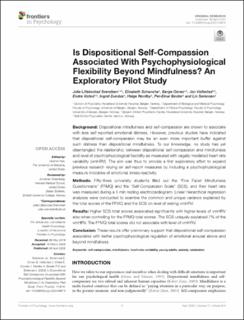| dc.contributor.author | Svendsen, Julie Lillebostad | |
| dc.contributor.author | Schanche, Elisabeth | |
| dc.contributor.author | Osnes, Berge | |
| dc.contributor.author | Vøllestad, Jon | |
| dc.contributor.author | Visted, Endre | |
| dc.contributor.author | Dundas, Ingrid | |
| dc.contributor.author | Nordby, Helge | |
| dc.contributor.author | Binder, Per-Einar | |
| dc.contributor.author | Sørensen, Lin | |
| dc.date.accessioned | 2021-06-24T10:34:04Z | |
| dc.date.available | 2021-06-24T10:34:04Z | |
| dc.date.created | 2020-12-10T12:45:19Z | |
| dc.date.issued | 2020 | |
| dc.identifier.issn | 1664-1078 | |
| dc.identifier.uri | https://hdl.handle.net/11250/2761090 | |
| dc.description.abstract | Background: Dispositional mindfulness and self-compassion are shown to associate with less self-reported emotional distress. However, previous studies have indicated that dispositional self-compassion may be an even more important buffer against such distress than dispositional mindfulness. To our knowledge, no study has yet disentangled the relationship between dispositional self-compassion and mindfulness and level of psychophysiological flexibility as measured with vagally mediated heart rate variability (vmHRV). The aim was thus to provide a first exploratory effort to expand previous research relying on self-report measures by including a psychophysiological measure indicative of emotional stress reactivity.
Methods: Fifty-three university students filled out the “Five Facet Mindfulness Questionnaire” (FFMQ) and the “Self-Compassion Scale” (SCS), and their heart rate was measured during a 5 min resting electrocardiogram. Linear hierarchical regression analyses were conducted to examine the common and unique variance explained by the total scores of the FFMQ and the SCS on level of resting vmHRV.
Results: Higher SCS total scores associated significantly with higher levels of vmHRV also when controlling for the FFMQ total scores. The SCS uniquely explained 7% of the vmHRV. The FFMQ total scores did not associate with level of vmHRV.
Conclusion: These results offer preliminary support that dispositional self-compassion associates with better psychophysiological regulation of emotional arousal above and beyond mindfulness. | en_US |
| dc.language.iso | eng | en_US |
| dc.publisher | Frontiers Media | en_US |
| dc.rights | Navngivelse 4.0 Internasjonal | * |
| dc.rights.uri | http://creativecommons.org/licenses/by/4.0/deed.no | * |
| dc.title | Is Dispositional Self-Compassion Associated With Psychophysiological Flexibility Beyond Mindfulness? An Exploratory Pilot Study | en_US |
| dc.type | Journal article | en_US |
| dc.type | Peer reviewed | en_US |
| dc.description.version | publishedVersion | en_US |
| dc.rights.holder | Copyright 2020 Svendsen, Schanche, Osnes, Vøllestad, Visted, Dundas, Nordby, Binder and Sørensen | en_US |
| dc.source.articlenumber | 614 | en_US |
| cristin.ispublished | true | |
| cristin.fulltext | original | |
| cristin.qualitycode | 2 | |
| dc.identifier.doi | 10.3389/fpsyg.2020.00614 | |
| dc.identifier.cristin | 1858271 | |
| dc.source.journal | Frontiers in Psychology | en_US |
| dc.identifier.citation | Frontiers in Psychology. 2020, 11, 614. | en_US |
| dc.source.volume | 11 | en_US |

